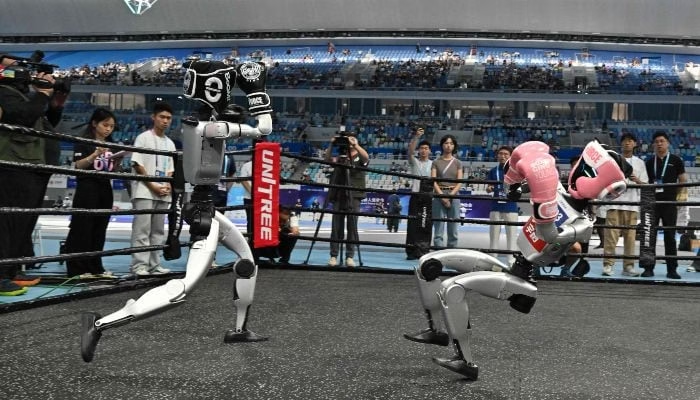The World Humanoid Robot Games 2025 have officially kicked off in Beijing, marking the first time in history that an international sports event has been dedicated exclusively to humanoid robots. Held at the National Speed Skating Oval — a venue originally built for the 2022 Winter Olympics — the event features over 500 advanced androids competing in everything from track events to kung fu, showcasing both the current capabilities and the exciting future potential of robotics.
A Global Gathering of Robotics Talent
Teams from 16 countries have brought their cutting-edge humanoid creations to Beijing, all vying for gold in a range of unique competitions. The World Humanoid Robot Games 2025 blend traditional athletic disciplines like the 100-metre hurdles, basketball, and five-a-side football with practical skill challenges such as medicine categorisation and automated cleaning.
For many spectators, the games are both fascinating and humorous. During the football match, robots — roughly the size of seven-year-old children — shuffled awkwardly around the pitch, often falling in piles or getting stuck in scrums. Yet in other areas, the sophistication was undeniable. In the 1,500-metre race, domestic champion Unitree’s humanoids demonstrated impressive speed, with the fastest completing the distance in 6:29:37 — far from the human record of 3:26:00, but still a sign of rapid progress.
“Robots Will Match Humans in a Decade”
Spectators have been captivated by the event’s mix of awkward tumbles and technological breakthroughs. Chen Ruiyuan, an enthusiastic 18-year-old attendee, told AFP, “I believe in the next 10 years or so, robots will be basically at the same level as humans.”
While human athletes may not yet be worried about losing their records, the sight of robots steadily improving in agility, speed, and precision has sparked serious conversation about the future of humanoid technology.
China’s National Strategy for Humanoid Robotics
The World Humanoid Robot Games 2025 are more than just entertainment — they’re part of China’s broader plan to position itself as a leader in robotics and artificial intelligence. The International Federation of Robotics recently noted that Beijing has placed humanoids at the centre of their national strategy,with heavy government backing and ambitious investment plans.
In March 2025, China announced a one-trillion-yuan (about $137 billion) fund to support technology startups, including robotics and AI ventures. The country is already the world’s largest market for industrial robots, and April saw Beijing host the first-ever humanoid robot half-marathon, further solidifying its leadership in this space.
Inspiring the Next Generation
The Games have also been designed to inspire young people to take an interest in robotics and STEM education. Parents and schools have been bringing students to the event, with some trips fully sponsored. Cui Han, who attended with her 10-year-old son, said, “I hope it will encourage him to learn more about these new technologies.”
For aspiring engineers like Chen, the event is more than entertainment — it’s a glimpse into their future careers. About to start university studies in automation, he said, Coming here can cultivate my passion for this field. My favourite is the boxing, because it requires a lot of agility and I can really see how the robots have improved from before.
From Kung Fu to Cleaning Tasks
The variety of events at the World Humanoid Robot Games 2025 is one of its biggest draws. Beyond athletic competitions, robots are tested on their ability to perform practical tasks such as sorting medical supplies and cleaning — skills that could have major applications in real-world industries.
In the kung fu arena, one pint-sized robot resembling a Transformer attempted a martial arts move, only to fall flat on its front. As it spun helplessly on the floor trying to get up, the crowd cheered in encouragement, highlighting the human tendency to root for these machines as if they were athletes themselves.
A Glimpse Into the Future of Robotics
While many of the robots still struggle with stability and coordination, their participation in the World Humanoid Robot Games 2025 represents a significant milestone. The combination of government investment, international collaboration, and growing public interest is accelerating advancements in humanoid robotics at a pace not seen before.
Experts believe that events like these will push developers to refine mobility, problem-solving, and adaptability — qualities essential for robots to function effectively in real-world environments.
The World Humanoid Robot Games 2025 are more than just a novelty sporting event; they’re a showcase of technological ambition, global cooperation, and the limitless potential of humanoid robotics. From comedic tumbles on the football field to lightning-fast 1,500-metre races, the Games reveal just how far robotics has come — and how much further it can go in the years ahead.
With China placing humanoid robots at the heart of its national strategy, and young spectators leaving inspired to join the field, it’s clear that the journey toward human-level robotics is well underway. Whether for sports, industry, or everyday life, the robots competing today could be the pioneers of tomorrow’s technological revolution.



